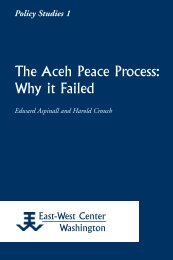Constructing Papuan Nationalism: History, Ethnicity ... - ScholarSpace
Constructing Papuan Nationalism: History, Ethnicity ... - ScholarSpace
Constructing Papuan Nationalism: History, Ethnicity ... - ScholarSpace
- No tags were found...
Create successful ePaper yourself
Turn your PDF publications into a flip-book with our unique Google optimized e-Paper software.
90 Richard Chauvel4. Fritz Kirihio has accredited Thaha Al Hamid, the Presidium Secretary General,with the idea of Perlurusan Sejarah (“Correcting the course of <strong>Papuan</strong> <strong>History</strong>”).Interview, Fritz Kirihio, Jakarta, July 5, 2003.5. I am indebted to Danilyn Rutherford for this observation.6. According to David Webster (2001: 507–28), this flag raising was the “foundationalmoment” for <strong>Papuan</strong> nationalism.7. Though it was not the first of the reformasi-era nationalist organizations, thePresidium Dewan Papua quickly became the foremost organization advocatingindependence. The late Theys Eluay was its best known leader. The Presidiumdeveloped out of an earlier movement known as FORERI (Forum RekonsiliasiMasyarakat Irian Jaya, Forum for Reconciliation in Irian Jaya), which had been amore broadly based coalition of Church, adat, and NGO leaders. The KongresPapua was dubbed the “Second” Congress, because the first had taken place inOctober 1961. That earlier congress is described later in the present section.8. Resolusi, Kongres Papua, Port Numbay (Jayapura), June 4, 2000. The UN resolutionwas actually passed on November 19, 1969.9. The ratification was issued by a congress of 1,025 carefully selected representatives.As discussed below, this act has long been criticized by <strong>Papuan</strong> nationalists.10. The three books edited by Agus Alua (2002a, 2002b, 2002c) are collections ofdocuments recording developments from the founding of FORERI in mid 1998to the <strong>Papuan</strong> Congress held in mid 2000. They were published by the PresidiumDewan Papua in its series on <strong>Papuan</strong> political education.11. PARNA sought to unite all <strong>Papuan</strong>s, develop a <strong>Papuan</strong> identity, and achieve independencewithin 10 years. See van der Veur (1963: 62, 64).12. This assertion was made even though, a year earlier, Indonesian Foreign MinisterAli Alatas (1998) had already denied the existence of the “Rome Agreement,” statingthat there had been no agreement between the Netherlands and Indonesiaconcerning Irian Jaya apart from the New York Agreement.13. Alua (2002a: 51). Some of Tom Beanal’s language reflects that used in the 1961Manifest Politik, which is discussed below. Copies of Manifest Politik were still incirculation, and the following year photocopies would be distributed at the 2000celebration of the anniversary of the first flag raising.14. The idea that Papua had once been independent and that the nationalist movementwas struggling to reclaim it was not new in <strong>Papuan</strong> thinking, although 1961had not always played such a central role in the account. E. J. Bonay, in his historyof the <strong>Papuan</strong> national awakening, argues that <strong>Papuan</strong>s were independent beforethe foreign colonizers arrived in the eighteenth century. The foreign colonizersrepressed the <strong>Papuan</strong>s and deprived them of their liberty. The struggle of the<strong>Papuan</strong> people has been to recapture their right of independence, taken from themfirst by the Dutch imperialists and now by Indonesia (Bonay c1980s: Bab 1, 1).15. Viktor Kaisiepo is the son of Markus Kaisiepo, one of the leading members of thefirst generation of <strong>Papuan</strong> nationalists and a man whose ideas and activities arediscussed below.
















